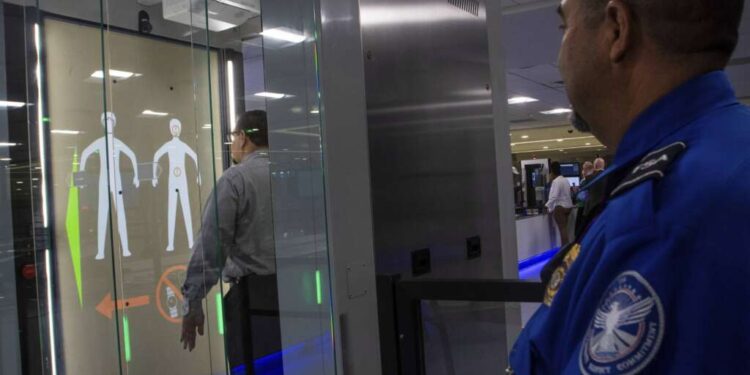
The Homeland Security Department is busy these days on a lot of fronts. Among the jobs not so visible: developing the next generation passenger screening technologies. Especially as passenger traffic keeps growing. Here with a report on some developments that promise to make screening both faster and more accurate from the DHS Science and Technology Directorate, John Fortune.
Tom Temin The program, I guess, has a name screening at speed. And the idea is this goal of just people being able to walk by something unobtrusive and be screened without the stopping, starting wanding, etc., etc.. And you’ve developed some lab technology that looks promising. Tell us about it.
John Fortune Yeah. So screening at speed is looking at really developing the next generation of technologies for the Transportation Security Administration, for TSA, and also trying to re-imagine the future a bit about what the art of the possible is in screening aviation security, maybe security for passengers as we think further down the road, 10 or 15 years down the road. So we have a number of technologies in development. And the one you referred to is an area where we’re investing in future screening for passengers to be able to make more accurate decisions and faster decisions to ultimately improve the experience of the passenger.
Tom Temin And the technology is millimeter wave. What is that and how does it work?
John Fortune We use millimeter technology to collect images of passengers to ensure that no threats that are not allowed on the plane are being brought through the security checkpoint. And it’s the technology, it’s already used in checkpoints today in standard TSA checkpoints. And with the millimeter wave, an image is created. Nobody looks at the image. It’s automatically analyzed by a computer algorithm that determines if there are any threat items on the passenger that require any additional attention or the passenger can continue on through the screening process. So using millimeter wave itself is not new, but we’ve come up with some new ways to build the technology using different wavelengths of millimeter wave in different configurations and really using some technology advances to come up with a better system that basically creates much sharper images. So now when the image is presented to a computer algorithm to determine whether there’s a threat or not, there’s a lot better chance of getting it right the first time. And especially what we want to do is avoid something called false alarms. False alarms just when a threat is detected. But there’s really no threat there. And that leads to secondary screening, often the pat down of the passenger, which nobody wants. So having that sharper image through this advanced millimeter wave technology, we can hopefully have a lot better screening efficiency and also avoid the pat downs that people hate when they’re going through the checkpoint.
Tom Temin In other words, it can change from just simply seeing a blob somewhere on that person to being able to say, that’s a cigarette pack and not to pistol magazine side by side.
John Fortune Yeah. So I want to be a little careful. The technology is not designed to distinguish one item from another item. We’re not quite there yet, but it’s to provide a sharper image to determine, is this actually an item somebody is carrying or perhaps they just have a thick pocket that is part of their pants or their clothing that actually is not an item at all. So in the current system, sometimes there are anomalies that show up that actually aren’t anything, and they result in secondary screening on the passenger. And we get that sharper image, then we can say, yes, there is at least an item there. It’s not supposed to have anything on the person as they go through this millimeter wave system. And it’s really that simple. And what we call high definition advanced imaging technology, or this new millimeter wave approach is going to help us make better decisions and avoid those pesky pat downs or not avoid them, but reduce them.
Tom Temin Sure. We’re speaking with Dr. John Fortune. He’s the program manager for Screening at Speed in the Homeland Security Science and Technology Directorate. And a moment ago, you mentioned nobody looks at the image. It’s some kind of an algorithm that decides whether it’s something to be looked at or not. Wouldn’t it be perhaps faster and more accurate if someone saw the image, because it doesn’t create an anatomy picture of the person, correct? What’s the issue? Is it a privacy issue?
John Fortune So the the image that is presented to an operator is just an avatar. So they are able to to see a generalized avatar that shows where an item might be located in a passenger, correct. But no images that show any kind of pictures are real to operators. It’s been that way for many years.
Tom Temin So therefore the idea of using an algorithm to evaluate the image is for speed, not for rather than having people look at each image that goes by, which is slower.
John Fortune It’s for speed, it’s for accuracy and it’s for privacy. It’s really for all three of us.
Tom Temin It seems like a lot of work has to happen on the algorithm, because the chance of so many things appearing alike, even to a high definition imaging system, seem pretty large.
John Fortune Yeah, and you’re definitely right there. A lot of our work going forward is going to be on algorithm development, because one of the interesting things about this high definition millimeter wave technology we’ve developed is we’re not just looking at utilizing technology to improve the current screening portals that we see in airports, but we’re looking at other ways that technology could be used to improve the screening process. So one of the ways that we’re looking at the ability of the technology working with our partners at TSA is, as I just said, basically a replacement or retrofit of the existing passenger screening systems. But the technology also holds a lot of promise for shoe scanning. We built a shoe scanner that uses that same technology so people potentially not have to remove their shoes as they go through the checkpoint. And then we’re also looking at, and even further down the road system, we’ve actually already built a laboratory prototype of that looks at real time imaging where somebody can walk through a portal and not have to stop at all. It all uses the same bones per se. It’s the same advanced millimeter wave screening technology. It’s just in one case used in a stationary portal, which is what we have today. In one case, it’s going, we’re looking at using it as a shoe scanner. And then a third case, we’re looking at it, using it as a real time screening system.
Tom Temin It sounds like the big challenge then is the physical deployment in the airport setting such that these things can be made at scale and fit into the space that is there already at the airport.
John Fortune That definitely is a challenge and something we’re working closely with our partners at TSA on. How do you implement a shoe scan or do you put it in with an existing portal system where the person already standing there and being screened in their shoes in a scan at the same time. Could it be put in place somewhere else within the checkpoint where it might increase efficiencies? And of course, anything real time screening does involve kind of reimagining what the checkpoint is, and that’s why I mentioned a screening speed is looking at that future vision for what the checkpoint might look like. But that’s something you said earlier. On the research and development side there is still a lot of work to be done on the algorithms, because we’re still working very diligently to develop the algorithms, not only for the portal, but for the shoe scanning and for the walk through. And it takes kind of a different approach to, it’s not a one size fits all algorithm. You have to develop algorithms that are specific to those different types of systems. And there’s still a lot of work to be done on the research and development and testing side before in particular, the shoe scanner and the real time walk by system are ready for deployment in the airport. We’re a little further along with the portal system, because that’s what we have right now.
Tom Temin And the processing of the imagery of the millimeter wave imagery and of the algorithm execution, that can all be done with standard type of hardware. In other words, you don’t need to build data centers at the airport to process the stuff.
John Fortune No, not at all. That’s part of our research and development is to figure out what kind of computational power is needed to process the images. And it’s always the same with that type of thing. More is better. But no, we’re not talking about building data farms at the airport. These are systems that are designed to work with fairly standard processing units on the computers that can be acquired commercially.
Tom Temin And just briefly, how does this get translated to the manufacture of equipment that would be, I guess, maybe TSA issue themselves. They would put it out for bid and whatever company can come up with the greatest panels in the least amount of time for lowest cost would get that contract.
John Fortune Yeah. Yeah, that’s a great question. And one of the things that’s important to point out is because the systems that we’ve built are basically, they were originally concepts and they were built into laboratory prototypes. One of our major research partners that we’ve been funding at DHS Science and Technology to build these systems is a Department of Energy Lab, Pacific Northwest National Laboratory out of Washington State. PNNL has built a number of prototypes on the stationary portal side, the shoe scanning side, and even as I mentioned, the one or two on the real time imaging walk through side. But they’re not a manufacturer. So one of the things that DHS commercialization office is working with the PNNL commercialization office to find commercial partners that we can license the technology to, that they will facilitate your company basically being able to pick up where we left off and figure out the most efficient ways to manufacture the systems, getting the cost down and ultimately being able to supply them to TSA when they do issue of procurement. So that’s a really important step in the process, because we’re doing the development and building maybe just a few of these prototypes to make sure they work, that they’re effective, and they can screen and meet TSA standards. But as far as actually getting a larger production run of these things at the airport. S&T doesn’t do that and not even our laboratory partners do that, it requires a partnership with industry. And we already have some licensing agreements in place or some of the approaches. And then we’re continuing to discuss with industry agreements for some of the other approaches.
Copyright
© 2025 Federal News Network. All rights reserved. This website is not intended for users located within the European Economic Area.







